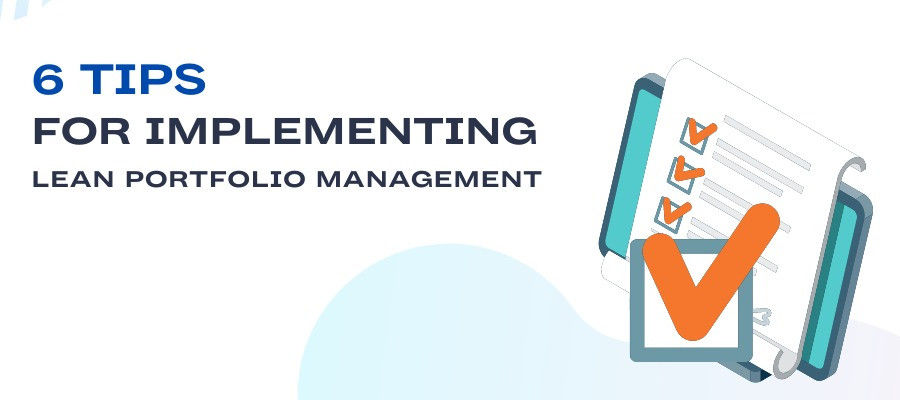6 Tips for Implementing Lean Portfolio Management in Large Portfolios

Implementing Lean Portfolio Management (LPM) in large portfolios is a complex undertaking that requires careful planning and strategic alignment. This article will explore six valuable tips for effectively implementing LPM in large organizations.
These tips are derived from real-world experiences and insights from the LPM community, providing practical guidance for organizations embarking on this journey.
Tip 1 – Align with Executive Leadership on the Reason for Change
Implementing LPM at a large organization entails significant changes to decision-making processes and impacts many stakeholders. It is crucial to align with executive leadership, strategy leaders, and senior financial leadership to articulate the existing portfolios and gain their support.
Establishing alignment with executive leadership on the desired outcomes and strategy lays the foundation for long-term success in implementing LPM. Here are some critical tips for aligning with executive leadership on the reason for change when implementing LPM:
- Clearly articulate the benefits of LPM to gain administrative support.
- Connect LPM to strategic goals and demonstrate alignment with the organization's objectives.
- Tailor the message to address the priorities and concerns of organizational leadership.
- Provide evidence and data to support the case for implementing LPM.
- Address potential problems and risks proactively.
- Foster open and transparent dialogue with executive leadership.
- Create a compelling vision of the future state with LPM implementation.
Tip 2 – Gain an Understanding of the Organization's Strategy
To drive innovative portfolios, it is essential to have a clear understanding of the organization's strategy. Collaborate with senior leaders and consider strategic shifts and market research to answer critical questions.
Identify the new portfolios that need to be created in the coming years, envision the desired results for future shareholder calls, and explore how current solutions can be optimized to provide a seamless end-user experience. Look for opportunities to connect and leverage existing solutions to improve outcomes.
Engage with senior leaders by exploring essential inquiries, drawing from strategic shifts and market research:
- What are the key market trends and emerging technologies may impact our industry in the next five years, and how should we adjust our portfolio accordingly?
- How can we better align our portfolio with the evolving needs and preferences of our target customers?
- Are there any underperforming portfolios or solutions we should consider phasing out or restructuring?
- How can we leverage strategic partnerships or acquisitions to strengthen our portfolio and expand our market reach?
- Are there any untapped market segments or opportunities we should explore with new portfolios or solutions?
Tip 3 – Discover and Map the Current Fiscal Decision Cycle of the Business
Every organization has its fiscal decision cycle, vital in budget allocation and resource management. Identify and map your organization's budgetary decision cycle, considering critical decision points and associated actions.
By mapping the fiscal process, similar to mapping a value stream, you gain valuable insights into how funding decisions are made, capital allocation is determined, and projects are initiated within the portfolio.
Tip 4 – Identify the Optimal Time for Change Implementation
Understanding the current state of your organization's decision-making process enables you to identify the best time for implementing significant changes, such as introducing LPM practices. Timing is crucial, as making changes at the wrong time can hinder adoption and effectiveness.
For example, if enterprise-level capital and operational expenditure goals are set in June, introducing a new approach in January might need more traction. Engaging with enterprise strategists in advance is advisable, allowing them time to plan and include the new direction in the next cycle.
Tip 5 – Create the Current State Portfolio Canvas to Drive Learning
Before integrating ARTs (Agile Release Trains) into a Lean-Agile portfolio, it is essential to understand the current state comprehensively. Collaborate with stakeholders to articulate and map the existing solution landscape.
By completing a portfolio canvas as a Lean Portfolio Management team, you ensure diverse perspectives are considered, enabling a more accurate depiction of the current portfolio state. Visualize how different ARTs bundles and value streams can align with enterprise goals and objectives.
Tip 6 – Launch One Portfolio at a Time with Careful Attention
Attempting to transition every portfolio to LPM simultaneously could be more practical and manageable. Instead, adopt a phased approach by launching one portfolio at a time and giving each portfolio attention it deserves. Utilize the practice guides for adopting LPM and ensure each portfolio goes through the defined steps. Maintain alignment between LPM implementations across portfolios and Enterprise Portfolio Management to foster synergy and cohesion.
Conclusion
Implementing Lean Portfolio Management in large portfolios is a transformative journey that requires strategic alignment, executive support, and a clear understanding of the organization's strategy. By following these six tips, organizations can navigate the complexities and challenges of implementing LPM effectively.
It is crucial to align with executive leadership, gain insights into the fiscal decision cycle, introduce changes at the opportune time, and create a comprehensive understanding of the current state. Additionally, launching portfolios one at a time and providing focused attention to each ensures a successful transition to Lean Portfolio Management, driving value and agility within the organization's portfolio management practices.
Reference
- https://scaledagile.com/blog/implementing-lpm-in-large-portfolios/
- https://www.gartner.com/smarterwithgartner/3-steps-to-start-lean-portfolio-management



